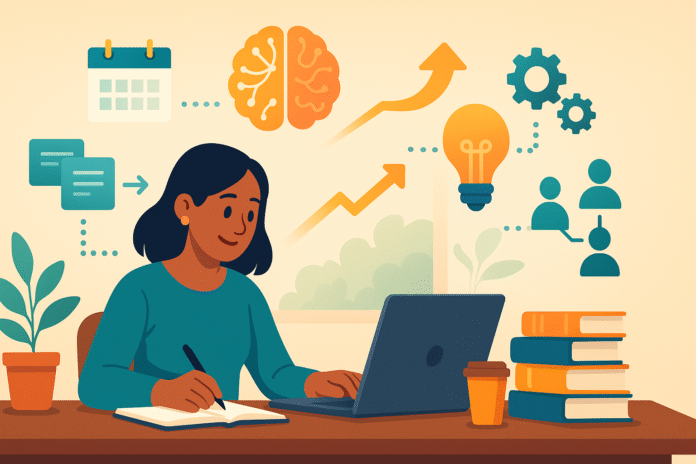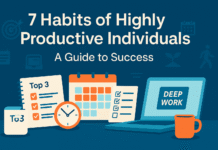In a world that changes faster than any single degree can cover, lifelong learning is the closest thing to a real superpower. It keeps your skills relevant, your brain flexible, and your confidence high when the ground under every industry keeps shifting. In the next few minutes, you’ll learn what lifelong learning actually is (beyond vague inspiration), how it rewires your brain for better memory and problem-solving, the simple systems and strategies that make growth sustainable, and exactly how to start—today.
This article is for curious professionals, students, and self-taught doers who want a practical, evidence-backed way to unlock their potential through lifelong learning.
Disclaimer: This guide is educational and is not a substitute for personalized medical, legal, or financial advice. Consult a qualified professional for decisions in those areas.
Key takeaways
- Lifelong learning is a repeatable cycle of choosing a goal, practicing with feedback, and showing your work—not a random binge of courses.
- Small, evidence-based techniques like retrieval practice, spaced repetition, and interleaving dramatically boost retention and transfer.
- Mindset and environment matter: build systems that make practice easy, track progress visibly, and engineer your surroundings to reduce friction.
- Progress compounds when you ship projects, teach others, and create a portfolio—credentials help, but impact speaks loudest.
- A simple 4-week starter plan (provided below) gets you from intention to traction, with built-in troubleshooting and metrics.
What Lifelong Learning Really Is (and Why It Works)
What it is & benefits
Lifelong learning is the ongoing, intentional development of knowledge and skills across your life. It’s less about hoarding facts and more about getting good at getting good—upgrading how you learn, not just what you learn. Done right, it helps you adapt to new tools and roles, stay employable, protect brain health, and build resilience when plans change.
Requirements & low-cost alternatives
- Time: 90–150 focused minutes per weekday is plenty; start with 25 minutes.
- Tools: Notebook or notes app; a spaced-repetition tool (any flashcard app); calendar or task manager.
- Cost-savvy: Use free open courses, library ebooks/audiobooks, YouTube university, and open-access research.
Step-by-step (beginner-friendly)
- Pick a one-sentence learning goal tied to a real outcome (e.g., “Automate weekly reports in Python within 30 days”).
- Choose one primary method (project, course, or mentorship). Don’t stack six.
- Schedule learning blocks (3–5× per week) and protect them like meetings.
- Practice with feedback every session (quizzes, code reviews, peer checks).
- Show your work weekly (post a demo, write a note, update a portfolio).
Beginner modifications & progressions
- If overwhelmed: Learn in 10–15 minute blocks; one concept per session.
- Progression: Move from following tutorials → remixing them → building from scratch and teaching others.
Recommended frequency & metrics
- Frequency: 3–5 sessions/week.
- KPIs: Sessions completed; retrieval quiz scores; one shipped artifact/week; portfolio entries/month.
Safety & common mistakes
- Mistake: Binging content with no practice.
- Fix: End every session with a retrieval check, a flashcard, or a tiny deliverable.
- Mistake: Switching topics too fast.
- Fix: Commit to a 4-week theme before pivoting.
Mini-plan (example)
- This week: Choose one skill, one course, one project.
- Today: Block 30 minutes; draft the project scope; create 10 flashcards.
How Learning Changes Your Brain
What it is & benefits
Learning physically reshapes neural connections (neuroplasticity), making future learning easier. Sleep strengthens new memories; spacing practice out, testing yourself, and mixing related topics all deepen retention and transfer. Movement and exercise support brain health and executive function.
Requirements & low-cost alternatives
- Tools: Flashcard app, timer, pen and paper.
- No-cost: Sleep routine (same wake time), short walks, body-weight exercise.
Step-by-step (evidence-based habits)
- Retrieval first, not rereading: Close the book and try to recall main ideas.
- Space it out: Review new material after 1 day, 3 days, 1 week, then monthly.
- Interleave topics: Alternate related problem types (e.g., algebra then geometry).
- Protect sleep: Aim for a consistent sleep/wake schedule; avoid all-nighters.
- Move daily: 20–30 minutes of brisk walking or strength work supports cognition.
Beginner modifications & progressions
- Start small: 5 retrieval questions per session.
- Progress: Build 10–20 flashcards per week and interleave two topics before adding a third.
Recommended frequency & metrics
- Frequency: Retrieval every session; spaced reviews on set days.
- KPIs: Retrieval accuracy; time-to-recall; review streaks; hours slept ≥ 7 on learning days.
Safety & common mistakes
- Mistake: Massed practice (cramming) that feels productive but fades fast.
- Fix: Short, frequent reviews beat long, infrequent ones.
- Mistake: Treating sleep as optional.
- Fix: Add “sleep” to your learning checklist; no late-night cramming before high-stakes tasks.
Mini-plan (example)
- Mon/Wed/Fri: 25-minute study + 5-minute retrieval quiz.
- Tue/Thu: 15-minute spaced review + 20-minute walk.
Mindset, Motivation, and Momentum
What it is & benefits
A growth-oriented mindset nudges you to see ability as improvable with practice and feedback. It doesn’t magically make you an expert, but it shifts your behavior toward strategies that work. Pair that with grit (long-term effort) and deliberate, feedback-rich practice for durable progress.
Requirements & low-cost alternatives
- Prompts: “What did I try? What did I learn? What will I adjust?”
- Feedback: Peer study groups, online communities, mentors; use free platforms.
Step-by-step
- Set input goals, not just outcomes (e.g., “3 practice sets/day” vs. “get an A”).
- Normalize struggle by keeping a “failure log” with the fix you tried.
- Add friction-reducing cues: Lay out materials the night before; auto-open study tabs.
- Use accountability: Weekly check-in with a friend or community.
Beginner modifications & progressions
- If confidence is low: Start with micro-wins (2 problems, 1 mini-build) and track streaks.
- Progress: Increase difficulty slowly; schedule higher-effort tasks early in the day.
Recommended frequency & metrics
- Frequency: 3–5 learning days/week; 1 accountability check-in/week.
- KPIs: Streak length; number of feedback loops/week; difficulty rating trend.
Safety & common mistakes
- Mistake: Chasing motivation.
- Fix: Build routines and friction-free environments; let motivation follow action.
- Mistake: Over-identifying with results.
- Fix: Track inputs and process improvements alongside outcomes.
Mini-plan (example)
- Friday: 10-minute review of the failure log; write 3 adjustments for next week.
Build Your Personal Learning OS (Systems, Not Willpower)
What it is & benefits
A lightweight “learning operating system” turns good intentions into reliable habits. Think: capture → distill → practice → ship → reflect. When your process is simple and visible, you learn more with less effort.
Requirements & low-cost alternatives
- Core stack: Notes app, spaced-repetition app, calendar, task list, portfolio folder.
- Low-cost: Use free tools you already have; don’t stall on “perfect software.”
Step-by-step
- Capture: Save ideas, links, and questions in one inbox folder or note.
- Distill: After each session, write a 5-sentence summary and 5 retrieval questions.
- Practice: Add the questions to spaced repetition; schedule the next session.
- Ship: Publish a weekly artifact (gist, blog, Loom demo, repo, sketch).
- Reflect: End the week with a 10-minute retro: What worked? What to change?
Beginner modifications & progressions
- Start: One notebook + one card deck + one weekly post.
- Progress: Tag notes (concept, example, question), add version control for projects, and set up a simple homepage/portfolio.
Recommended frequency & metrics
- Frequency: Daily capture; 3–5 practice sessions/week; ship weekly.
- KPIs: Cards created; review completion rate; artifacts shipped; portfolio views.
Safety & common mistakes
- Mistake: Tool-chasing.
- Fix: Commit to your stack for 4 weeks; review only after the cycle ends.
Mini-plan (example)
- Sunday setup: Create “Learning” calendar + “Inbox” note + “Deck 01” in your flashcard app.
- Daily: Capture → distill → add 3 cards.
Methods That Actually Work (and How to Use Them)
Project-Based Learning
Purpose: Learn by building something that matters. Projects create context, force retrieval, and produce evidence of skill.
Requirements: A clear scope, a deadline, a way to share the result.
Low-cost: Use free datasets, templates, starter repos, or community briefs.
Steps:
- Define a user and outcome (e.g., “Automate report for team X”).
- Break into 3–5 milestones with dates.
- Ship a prototype by the end of week 2; iterate.
Beginner mods & progressions:
- Start with a weekend micro-project.
- Level up by adding tests, documentation, and performance metrics.
Frequency & metrics:
- One project/month; weekly milestone demos; stars/issues/comments if public.
Safety & mistakes:
- Mistake: Perfection paralysis.
- Fix: “Prototype by Friday” rule.
Mini-plan:
- Scope today → prototype this week → demo next week.
Teach-Back Method
Purpose: Explaining forces clarity and reveals gaps.
Requirements: Audience of one works—friend, colleague, camera.
Steps:
- Create a 5-minute outline.
- Record a quick explainer.
- Note what you had to look up; make flashcards.
Beginner mods: Use slides with simple visuals.
Progress: Go live to a small group; invite questions.
Frequency & metrics: Weekly; count “questions I can now answer.”
Common mistake: Reading slides. Fix: Picture examples instead.
Mini-plan:
- Friday “Explain Like I’m 5” video (unlisted) + reflection note.
Mentorship & Communities
Purpose: Shorten feedback loops; see blind spots; get unstuck faster.
Requirements: Clear ask; a cadence; willingness to show drafts.
Steps:
- Join one relevant community.
- Post work-in-progress weekly.
- Book a 15-minute feedback call each month.
Beginner mods: Asynchronous feedback only.
Progress: Offer to help others; lead a tiny study circle.
Frequency & metrics: Weekly posts; monthly calls.
Common mistake: Vague questions. Fix: Share your attempt + what you tried.
Mini-plan:
- Write a public learning goal; share your first artifact next week.
Microlearning (Short, Focused Bursts)
Purpose: Fit learning into busy days and keep a high tempo of wins.
Requirements: A queue of 10–15 minute tasks and reviews.
Steps:
- Break lessons into “one concept, one exercise.”
- End with a retrieval quiz or flashcards.
- Log the session in your tracker.
Beginner mods: Learn on commutes or lunch breaks.
Progress: Chain 3 micro-sessions into a power hour.
Frequency & metrics: Daily; track streaks and cumulative minutes.
Common mistake: Consuming without creating. Fix: Always output something small.
Mini-plan:
- 3 micro-tasks/day, each with a 3-question check.
Choose What to Learn Next (Strategically)
What it is & benefits
Not all skills compound equally. Anchor your learning to roles you want, problems you care about, and skills with cross-domain leverage: analytical and creative thinking, tech literacy, communication, and decision-making.
Requirements & low-cost alternatives
- Inputs: 10 job postings, one role model’s portfolio, three public roadmaps.
- Low-cost: Use free labor-market insights, industry blogs, and open datasets.
Step-by-step
- Map a 12-month theme (e.g., “data storytelling for ops”).
- Pick two skill pillars (e.g., Python automation + business writing).
- Draft a 4-week project that touches both.
Beginner modifications & progressions
- If undecided: Shadow someone for a day or do a weekend sampler project.
- Progress: Add a third pillar only after a successful project.
Recommended frequency & metrics
- Update your skill map each quarter; track role-relevant artifacts.
Safety & common mistakes
- Mistake: Chasing hype without fit.
- Fix: Start with problems you actually face; pull skills from there.
Mini-plan (example)
- This weekend: Collect 10 job listings; highlight repeated skills; design one project to practice them.
Overcoming the Big Barriers (Time, Distraction, Fear, Cost)
What it is & benefits
Most “lack of learning” isn’t a motivation problem—it’s an operating-conditions problem. Fix the environment first.
Requirements & low-cost alternatives
- Time: Batch chores; use “study sprints” with a timer.
- Focus: Website blockers; phone in another room.
- Cost: Libraries, open courseware, scholarships, peer swaps.
- Confidence: Start with micro-wins; find a learning buddy.
Step-by-step fixes
- If time-poor: Swap 30 minutes of scrolling for 2 micro-sessions.
- If distracted: “Headphones + one tab” rule; full-screen your work window.
- If anxious: Reframe mistakes as data; keep a log of wins and fixes.
- If broke: Use free tools; barter skills for feedback.
Beginner modifications & progressions
- Start: 2 sessions/week.
- Progress: Add a third session and a weekly demo.
Recommended frequency & metrics
- Track focus minutes; count “interruption-free” sessions; measure output per week.
Safety & common mistakes
- Mistake: Comparing your draft to someone’s polished portfolio.
- Fix: Compare today’s work to last month’s work.
Mini-plan (example)
- Tonight: 20-minute sprint with all notifications off; post one question to your community.
Measure What Matters (Proof of Progress)
What it is & benefits
You can’t manage what you don’t measure. Metrics turn vague effort into visible progress.
Requirements & low-cost alternatives
- Dashboard: A simple spreadsheet or habit tracker.
- Portfolio: A public folder or site, or a pinned repo.
Steps
- Track inputs (sessions, minutes) and learning quality (retrieval score, review completion).
- Track outputs (artifacts shipped, demos, posts).
- Track outcomes (interview invites, project adoption, revenue, user impact).
Beginner modifications & progressions
- Start: Count sessions and one weekly artifact.
- Progress: Add outcome metrics; request external feedback monthly.
Recommended frequency & metrics
- Weekly review; monthly summary post.
Safety & common mistakes
- Mistake: Gaming metrics.
- Fix: Balance input, output, and outcome metrics.
Mini-plan (example)
- Sunday: Update your dashboard; choose one metric to improve next week.
Safety, Caveats, and Avoiding Traps
- Information hygiene: Vet sources, cross-check claims, and beware of pay-to-play “certifications.”
- Health: Respect sleep and breaks; avoid marathon sessions that tank retention.
- Ergonomics: Neutral wrist and spine positions; 5-minute movement break each hour.
- Expect plateaus: Skill growth is stepwise; keep practicing through the flat spots.
- Hype traps: “One-week mastery” isn’t real; consistent practice wins.
Quick-Start Checklist
- One-sentence learning goal tied to a real outcome
- Simple stack (notes, calendar, flashcards, portfolio folder)
- 3–5 weekly blocks on your calendar
- Retrieval questions after every session
- Spaced reviews scheduled
- One artifact shipped each week
- Weekly 10-minute retro
A Simple 4-Week Starter Plan
Theme: “Learn the basics of data analysis and present a dashboard.”
Adjust the topic to your field; keep the structure.
Week 1 — Foundation & Setup
- Focus: Terminology, tooling (spreadsheet or Python/R basics), and data ethics.
- Inputs: 4 sessions × 30–45 min.
- Outputs: 10 flashcards; “What I’ll build” one-pager.
- Practice: Retrieval quiz at the end of each session.
- Milestone: Import a dataset and compute three simple metrics.
- Pitfalls to avoid: Over-installing tools; pick one and move.
Week 2 — Core Skills & First Prototype
- Focus: Cleaning data, basic charts, and descriptive statistics.
- Inputs: 5 sessions × 45–60 min.
- Outputs: Prototype chart or mini-dashboard; 20 new flashcards.
- Practice: Interleave tasks (clean → chart → explain).
- Milestone: Share a 3-minute demo with a peer.
- Pitfalls: Waiting to share until “perfect.” Ship the draft.
Week 3 — Feedback & Iteration
- Focus: Improving clarity, adding a narrative, and automating one step.
- Inputs: 4 sessions × 45–60 min.
- Outputs: Version 2 with better labels/legends; tutorial notes.
- Practice: Teach-back session; record yourself explaining choices.
- Milestone: Incorporate peer feedback; create 15 more flashcards.
- Pitfalls: Ignoring usability; ask a non-expert to interpret your chart.
Week 4 — Polish & Publish
- Focus: Final presentation, documentation, and reflection.
- Inputs: 4 sessions × 45–60 min.
- Outputs: Final dashboard + 500-word write-up; portfolio post.
- Practice: Final retrieval quiz; schedule spaced reviews.
- Milestone: Publish and share with your community or manager.
- Pitfalls: Scope creep; freeze features mid-week.
Troubleshooting & Common Pitfalls
- “I don’t remember anything I study.”
Use retrieval practice first, then reread. Add spaced reviews at 1, 3, 7, and 30 days. - “I keep procrastinating.”
Shrink the task to 10 minutes, start a timer, and commit to one tiny deliverable (e.g., one problem, one paragraph). - “I forget to review.”
Put reviews on your calendar and enable app notifications. Pair reviews with a daily habit (morning coffee). - “I stall at ‘advanced beginner.’”
Add deliberate practice: choose one subskill, define a measurable standard, get targeted feedback. - “I’m overwhelmed by resources.”
One course + one project + one mentor/community. Everything else goes to a “later” list. - “I learn but can’t explain it.”
Teach it back. Record a 3-minute explainer; gaps tell you what to practice next. - “I’m worried about wasting time on the wrong skill.”
Tie learning to a problem you actually have and validate with job postings or user needs. - “My industry is changing too fast.”
Focus on cross-cutting skills: analytical thinking, creativity, tech literacy, communication.
FAQs
- How much time should I dedicate to lifelong learning each week?
Start with 3–5 sessions of 25–45 minutes. Consistency beats marathons. Increase only after you’ve sustained a 2-week streak. - What if I can’t afford paid courses or certificates?
Use open-access courses, public datasets, library ebooks, and community mentors. Projects and portfolios often matter more than certificates. - How do I choose between breadth and depth?
Alternate 4-week sprints: one focused on a core skill (depth), one on a complementary skill (breadth). Keep a through-line via a unifying project. - How do I retain information long-term?
Use retrieval practice and spaced repetition. Mix related topics (interleaving) and sleep on it—consistency matters more than intensity. - What’s the best way to get feedback if I’m learning solo?
Post work-in-progress in a small community, ask targeted questions, and request one concrete suggestion. Consider short, monthly mentor calls. - How do I measure progress beyond “hours studied”?
Track retrieval scores, artifacts shipped, external feedback received, and real-world impact (e.g., time saved, bugs fixed, users helped). - Is a growth mindset enough to guarantee success?
No single mindset guarantees results. Use it to adopt effective strategies, seek feedback, and persist—then pair it with structured, deliberate practice. - How do I prevent burnout?
Keep sessions short, take movement breaks, protect sleep, and rotate between learning modes (watch → do → teach). Schedule one week off every couple of months. - Do I need to specialize early?
Not always. Early generalism builds transferable mental models. Specialize by shipping projects that integrate your interests with market needs. - What if I fall behind on the 4-week plan?
Cut scope, not the habit. Finish a smaller version, extract lessons, and start a new sprint with those adjustments. - How do I stay motivated over years, not weeks?
Build identity (“I am the kind of person who learns daily”), celebrate small wins, and connect learning to people who benefit from your work. - What tools do you recommend to start?
Whatever you’ll actually use: a simple notes app, a free flashcard app, your calendar, and a place to publish (a repo or blog). Tools matter less than habits.
Conclusion
Lifelong learning isn’t about being endlessly busy; it’s about building a life where growth is the default. With small, repeatable practices—retrieval, spacing, interleaving—plus systems that make progress visible, you can adapt faster, think clearer, and create work you’re proud to share. Start with one goal, one project, and one weekly artifact. Momentum does the rest.
CTA: Pick a skill and schedule your first 25-minute session today—then ship a tiny artifact by Friday.
References
- Exploring the Role of Neuroplasticity in Development and Brain Function — National Library of Medicine (PMC). 2023. https://pmc.ncbi.nlm.nih.gov/articles/PMC10741468/
- Adult Neuroplasticity: More Than 40 Years of Research — National Library of Medicine (PMC). 2014. https://pmc.ncbi.nlm.nih.gov/articles/PMC4026979/
- Tips to Leverage Neuroplasticity to Maintain Cognitive Fitness as You Age — Harvard Health Publishing. April 2, 2025. https://www.health.harvard.edu/mind-and-mood/tips-to-leverage-neuroplasticity-to-maintain-cognitive-fitness-as-you-age
- Retrieval Practice Is Effective Regardless of Self-Reported Need for Cognition — National Library of Medicine (PMC). 2022. https://pmc.ncbi.nlm.nih.gov/articles/PMC8866974/
- Using Retrieval Practice to Increase Student Learning — Washington University in St. Louis Center for Teaching and Learning. Accessed 2025. https://ctl.wustl.edu/resources/using-retrieval-practice-to-increase-student-learning/
- Evidence of the Spacing Effect and Influences on Study Habits — National Library of Medicine (PMC). 2022. https://pmc.ncbi.nlm.nih.gov/articles/PMC8759977/
- Spacing Repetitions Over Long Timescales: A Review and a Reconsolidation Account of the Spacing Effect — National Library of Medicine (PMC). 2017. https://pmc.ncbi.nlm.nih.gov/articles/PMC5476736/
- Interleaved Practice Enhances Memory and Problem Solving — National Library of Medicine (PMC). 2021. https://pmc.ncbi.nlm.nih.gov/articles/PMC8589969/




































